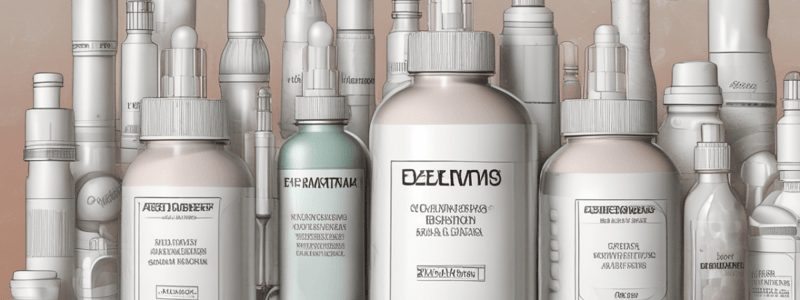Podcast
Questions and Answers
What is the typical size range of droplets in emulsions?
What is the typical size range of droplets in emulsions?
- 0.1 – 100 μm (correct)
- 1 – 1000 μm
- 0.01 – 1 μm
- 10 – 1000 μm
What is the main advantage of using emulsions in oral administration of oils and oil-soluble drugs?
What is the main advantage of using emulsions in oral administration of oils and oil-soluble drugs?
- Enhanced palatability (correct)
- Reduced absorption
- Increased toxicity
- Increased dose frequency
What is the main characteristic of o/w emulsions in terms of miscibility?
What is the main characteristic of o/w emulsions in terms of miscibility?
- Miscible with both oil and water
- Miscible with oil
- Immiscible with both oil and water
- Miscible with water (correct)
What determines the type of emulsion formed by an emulsifying agent?
What determines the type of emulsion formed by an emulsifying agent?
What is the ideal property of an emulsifying agent in terms of toxicity?
What is the ideal property of an emulsifying agent in terms of toxicity?
What is the primary function of tragacanth in emulsions?
What is the primary function of tragacanth in emulsions?
Which type of emulsifying agent is suitable for internal preparations due to its non-toxic and non-irritant properties?
Which type of emulsifying agent is suitable for internal preparations due to its non-toxic and non-irritant properties?
What is the primary reason for choosing an emulsifying agent?
What is the primary reason for choosing an emulsifying agent?
Which of the following emulsifying agents is suitable for parenteral use?
Which of the following emulsifying agents is suitable for parenteral use?
What is the purpose of flavouring agents in polysorbate emulsions?
What is the purpose of flavouring agents in polysorbate emulsions?
What is the primary reason why acacia is not used externally in emulsions?
What is the primary reason why acacia is not used externally in emulsions?
What is the purpose of antimicrobial preservatives in emulsions?
What is the purpose of antimicrobial preservatives in emulsions?
What happens when the interfacial film of an emulsion is broken?
What happens when the interfacial film of an emulsion is broken?
What is the effect of increasing the chain length of macrogols?
What is the effect of increasing the chain length of macrogols?
What is the primary characteristic of vegetable oils used in skin preparations?
What is the primary characteristic of vegetable oils used in skin preparations?
What is the characteristic of silicone oils?
What is the characteristic of silicone oils?
What is the composition of hydrous wool fat?
What is the composition of hydrous wool fat?
What is the purpose of surfactants in ointments?
What is the purpose of surfactants in ointments?
At what temperature are oily components melted in the preparation of creams?
At what temperature are oily components melted in the preparation of creams?
When are unstable and insoluble drugs added to creams?
When are unstable and insoluble drugs added to creams?




